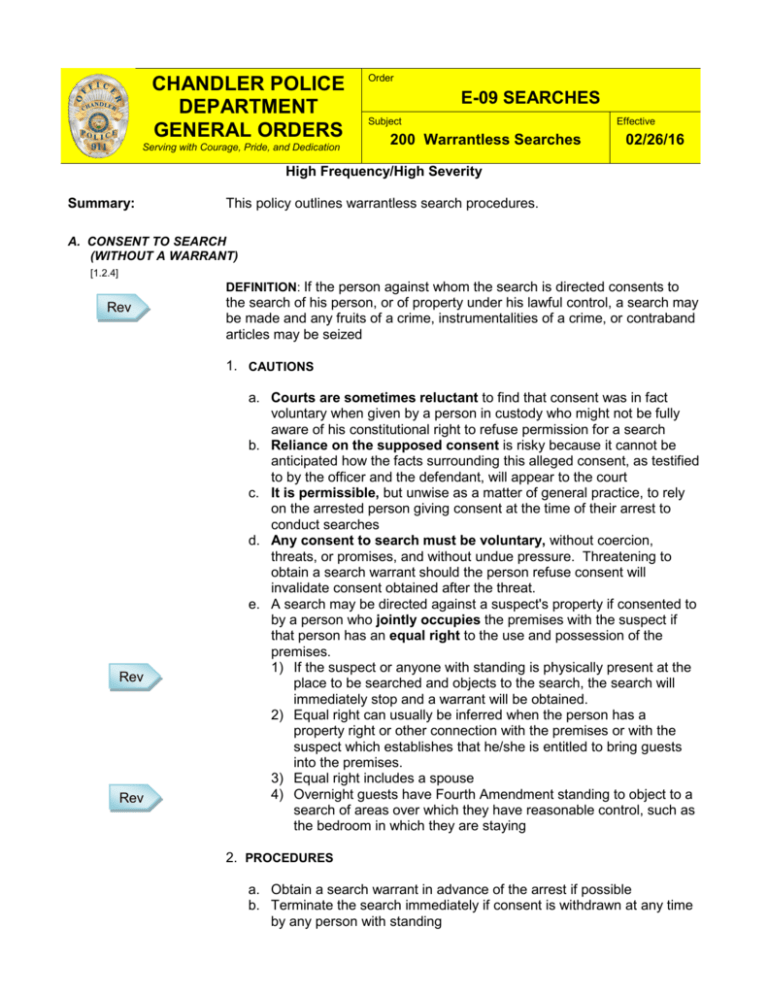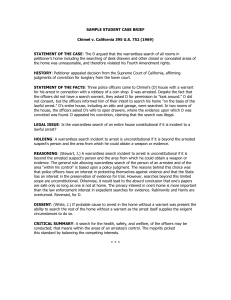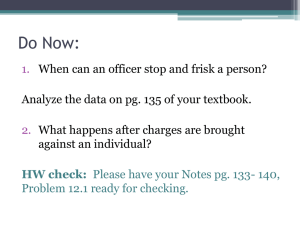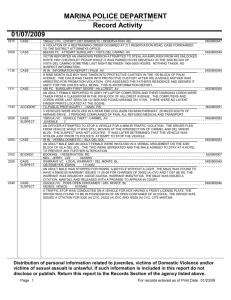E-09.200 Searches: Warrantless
advertisement

CHANDLER POLICE DEPARTMENT GENERAL ORDERS Serving with Courage, Pride, and Dedication Order E-09 SEARCHES Subject 200 Warrantless Searches Effective 02/26/16 High Frequency/High Severity Summary: This policy outlines warrantless search procedures. A. CONSENT TO SEARCH (WITHOUT A WARRANT) [1.2.4] DEFINITION: If the person against whom the search is directed consents to Rev the search of his person, or of property under his lawful control, a search may be made and any fruits of a crime, instrumentalities of a crime, or contraband articles may be seized 1. CAUTIONS Rev Rev a. Courts are sometimes reluctant to find that consent was in fact voluntary when given by a person in custody who might not be fully aware of his constitutional right to refuse permission for a search b. Reliance on the supposed consent is risky because it cannot be anticipated how the facts surrounding this alleged consent, as testified to by the officer and the defendant, will appear to the court c. It is permissible, but unwise as a matter of general practice, to rely on the arrested person giving consent at the time of their arrest to conduct searches d. Any consent to search must be voluntary, without coercion, threats, or promises, and without undue pressure. Threatening to obtain a search warrant should the person refuse consent will invalidate consent obtained after the threat. e. A search may be directed against a suspect's property if consented to by a person who jointly occupies the premises with the suspect if that person has an equal right to the use and possession of the premises. 1) If the suspect or anyone with standing is physically present at the place to be searched and objects to the search, the search will immediately stop and a warrant will be obtained. 2) Equal right can usually be inferred when the person has a property right or other connection with the premises or with the suspect which establishes that he/she is entitled to bring guests into the premises. 3) Equal right includes a spouse 4) Overnight guests have Fourth Amendment standing to object to a search of areas over which they have reasonable control, such as the bedroom in which they are staying 2. PROCEDURES a. Obtain a search warrant in advance of the arrest if possible b. Terminate the search immediately if consent is withdrawn at any time by any person with standing SEARCHES - Warrantless 02/26/16 CPD GO E-09.200 Page 2 c. Complete the department's consent to search form and obtain the signature of any person with standing (recommended) d. Record all consent to search requests to document request (strongly recommended) B. SEARCH INCIDENT TO ARREST [1.2.4] [1.2.8] Rev 1. WARRANTLESS SEARCHES of the person incident to a lawful arrest are valid: a. When an officer makes a full “custodial” arrest, and the subject is being transported to the station or booking facility b. To seize weapons or other articles which might be used to attack the officer c. To seize the means the suspect might use to effect his escape d. To prevent the destruction of the fruits or instrumentalities of the crime or evidentiary items of the crime for which the arrest was made 2. WITHIN REACH: Search beyond the person must be limited to those areas which remain within the reach of the arrestee Rev a. Reach is not confined to arm's length but includes the areas reachable by the person if he made a lunge or quick move to gain possession of a weapon or of destructible evidence b. If it is necessary for the person arrested to move about after his arrest to put on clothing or assemble belongings, those areas to which he continues to have access may also be searched for weapons or destructible evidence. This movement must be a result of the arrestee’s desire to do so. It cannot be directed or requested by the officer. c. May conduct a warrantless search of a vehicle incident to a recent occupant's arrest only if: 1) The arrestee is within reaching distance of the passenger compartment at the time of the search or 2) It is reasonable to believe the vehicle contains evidence of the offense of arrest. Under this justification, police may search the entire passenger compartment and all containers in the passenger compartment, locked or unlocked, regardless of ownership. If neither justification is present, a search of an arrestee's vehicle is allowed only if police obtain a warrant or show that another exception to the warrant requirement applies. Arizona v. Gant (U.S. Supreme Court 2009) . 3. SEARCHING THE PREMISES: Evidence obtained in a search of the premises at the time of arrest is admissible in court if there are justifiable facts showing all of the following circumstances: a. There was probable cause for the search (sufficient ground upon which a search warrant could have been obtained) b. Exigent circumstances existed that would make it impossible to safeguard the premises while a search warrant was being obtained after the arrest c. Exigent circumstances existed requiring the making of the arrest before a search warrant could be obtained SEARCHES - Warrantless 02/26/16 CPD GO E-09.200 Page 3 4. UPON ARREST, the arresting officer will search the suspect and any areas within the suspect's immediate control or areas within which he might gain possession of a weapon or destroy evidence shortly after taking the suspect into custody a. A search must be thorough and should not be discontinued when one weapon is found. There may be more than one. b. Officers receiving custody of a prisoner from another officer will search the prisoner before placing the prisoner in a police vehicle c. An officer of the same sex as the prisoner should conduct the search 1) If not practical, handcuff the prisoner with hands behind the back frisk for weapons using the blade edge or back of the hand for the search 2) Remove purses, knapsacks, or other similar articles used to carry items from the prisoner upon arrest d. When booking a prisoner, only a person of the same sex as the prisoner will search a prisoner. If at all possible, search prior to transport. If no same sex employee is available, the search will be done at the county jail. 5. TYPES OF SEARCHES: The types of searches include the standing search, kneeling and prone search, wall search, and strip search. The officer will determine the appropriate type of search to use. a. The standing search: Considered the most versatile and should be used in most non-high-risk arrest situations b. The wall search: Use for most detainees entering the detention area c. The kneeling and prone search: May be used with high-risk detainees and for group searches d. Strip searches: Must be authorized by a sergeant or higher-ranking supervisor 1) Conducted in the privacy of the temporary detention area by department employees of the same sex as the prisoner 2) Only a supervisor and the person conducting the search will be present for the search. If no same sex employee and supervisor are available, have the search done at the county jail. 3) The following should be documented in a departmental report: a) Reason for search b) Persons conducting search c) Location of search d) Extent of search e. Body cavity search: Conducted only by virtue of a search warrant or by consent of the suspect, and then only by a medical doctor. An arresting officer must have a reasonable belief that the prisoner is concealing weapons or contraband. C. STOP AND FRISK [1.2.4] REFERS TO THE “LIMITED SEARCH” of a person for weapons for the officer's protection during an investigative detention. A frisk may be done with only reasonable suspicion (less than probable cause) that the person may have been or may be committing, or may be about to commit a crime or violation and reasonable suspicion that the person may be armed and presently dangerous. SEARCHES - Warrantless 02/26/16 CPD GO E-09.200 Page 4 1. FOR THE SOLE PURPOSE OF PROTECTING the officer, officers may conduct a limited frisk or "pat down" of the outer clothing of the suspected person to discover weapons that might be used to assault that officer 2. SUSPICIOUS ACTIVITY OR BEING IN A HIGH CRIME AREA ALONE will not allow a frisk. The officer must be able to articulate: a. Reasonable suspicion to justify stopping the person b. Additional reasonable suspicion to justify frisking the person (armed and presently dangerous) 3. IF THE ABOVE FACTS EXIST, the officer may frisk, or "pat down," the person for weapons and shall do so immediately upon safe initial contact, including a frisk of any items the person may be carrying where a weapon may be located 4. CITIZENS being given transportation must consent to be frisked for weapons as a matter of officer safety. If the person refuses, then you should not provide transportation. 5. FRISK OF VEHICLE PASSENGERS is allowed as long as officer has separate reasonable suspicion that the passenger is armed and presently dangerous 6. PROTECTIVE SEARCH OF PASSENGER COMPARTMENT OF A VEHICLE, limited to those areas in which weapons may be placed or hidden, is allowed if there is reasonable belief that suspect is dangerous and may gain immediate control of weapons in the vehicle. Michigan v. Long, 463 U.S. 1032 (1983). a. Protective search of vehicle can be performed even if suspect is under police control at time of vehicle frisk if suspect is to be released back to the vehicle after detention is completed b. Protective search of vehicle trunk not permitted under this exception D. VEHICLE SEARCHES [1.2.4] VEHICLE EXCEPTION: Automobiles and other conveyances may be completely searched without a search warrant only if there is probable cause to believe that the vehicle contains evidence or instrumentalities of a crime 1. IF PROBABLE CAUSE EXISTED TO SEARCH A VEHICLE when it came into the custody of an officer, a warrantless search may extend anywhere in the vehicle including closed containers in which the items being searched for may be found 2. IF PROBABLE CAUSE EXISTS TO SEARCH A CONTAINER that is in a vehicle, a search warrant is not necessary to search the container, even though there is no probable cause to search the entire vehicle 3. IF PROBABLE CAUSE EXISTS TO SEARCH A VEHICLE, that search may take place at the location where the vehicle is seized, or the vehicle may be transported to another location to be searched (safety, lighting, equipment concerns). Such searches should be conducted as soon as practicable after the vehicle has been transported to a new location. SEARCHES - Warrantless 02/26/16 CPD GO E-09.200 Page 5 E. EXIGENT CIRCUMSTANCES An officer may enter premises without a warrant or consent under exigent circumstances that have not been created by the officer in the following situations, recognized by the courts as exceptions: 1. TO ARREST A FLEEING FELON in hot pursuit: The attempt to make the initial arrest must have taken place in a public place 2. EMERGENCY AID or response to an emergency call: Officers having reasonable grounds to believe there is an emergency at hand and immediate need for their assistance for the protection of life or property may enter a premise - in other words, to look for a person who may be ill, injured, or dead 3. PROBABILITY OF DESTRUCTION OF EVIDENCE: Officers must present facts amounting to probable cause to explain why they believed the evidence would be destroyed if they waited to obtain a search warrant applies to felony crimes only 4. KNOWLEDGE THE PERSON WANTED IS FLEEING OR ABOUT TO FLEE: When an officer has reason to believe that the person will probably flee and that person is subject to an felony arrest warrant or there is probable cause to arrest the person for a felony, the officer may enter a premises to affect an arrest only if it is immediately necessary to prevent the suspect’s escape. 5. RISK OF VIOLENCE: Includes domestic violence or 911 calls where reports of violence are given or heard - entry into the premises to prevent injury or violence is acceptable a. If one party is outside in a safe location prior to officers’ arrival and the potential for violence has ended, then officers must get consent or a search warrant prior to entering the premises b. Officers making a valid arrest inside of a residence or immediately outside of a residence may perform a “protective sweep” of the residence if they have information to support the fear that someone may be inside the residence who can come out and harm them while effecting the arrest (Under limited circumstances, i.e., shooting calls or threats against officers, while conducting investigations at residences where persons are detained, officers may conduct a protective sweep of the residence.) 6. A SUBSTANTIAL RISK OF HARM to the persons involved or to the law enforcement process if the police must wait for a warrant F. PLAIN VIEW SEIZURES 1. AN OFFICER LAWFULLY PRESENT on the premises may seize evidence that he has probable cause to believe is crime related 2. OFFICERS OUTSIDE OF A PREMISES who observe contraband inside must obtain a search warrant unless the entry and seizure of the item falls under one of the exigent circumstance exceptions SEARCHES - Warrantless 02/26/16 CPD GO E-09.200 Page 6 G. PROBATION ASSISTANCE [1.2.4] 1. OFFICERS MAY ASSIST PROBATION OFFICERS in searching individuals, their vehicles, or premises, who as terms of their probation have given up the expectation of privacy of their person, home, and/or vehicles 2. THE OFFICER MAY SEIZE ITEMS of evidence and subsequently charge the person with any applicable criminal violations. See also General Order E-04.300 H. INVENTORY FOR PROTECTION OF PROPERTY [1.2.4] 1. OFFICERS WILL CONDUCT AN INVENTORY of all vehicles or property of which they have lawful custody in order to protect the property of the suspect/owner from theft and to protect the police from claims of theft. This inventory shall occur as soon as practicable after obtaining custody of the property. a. Include the inspection of all locked and/or closed containers b. Document the results of the inventory on the offense or tow report and/or in the narrative section of the report 2. INVENTORY SOLELY TO PROTECT an arrested driver's possessions a. It is completely non-exploratory and is not a search b. It can best be justified if the officer has very little or no reason to believe that evidence is in the vehicle c. Open closed containers whose content officers are unable to determine from examining the container’s exterior for inventory I. PROTECTIVE SWEEP 1. Incident to an arrest in a home, police may conduct a warrantless, protective sweep defined as "a quick and limited search of the premises conducted to protect the safety of police officers or others and must be narrowly confined to a cursory visual inspection of those places in which a person might be hiding.” (Maryland v. Buie, U.S. Supreme Court, 1990) a. Done as precaution b. Does not require PC or reasonable suspicion c. Officers may look in closets and other spaces immediately adjoining the place of arrest from which an attack could be immediately launched 2. If the sweep goes beyond those areas, there must be reasonable suspicion based on the facts that the area to be swept harbors an individual posing a danger to those on the arrest scene ✦✦✦








